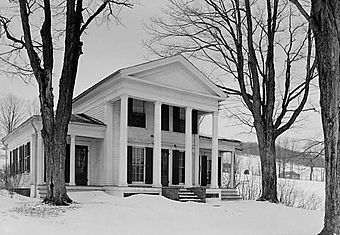Cyrus Gates Farmstead facts for kids
Quick facts for kids |
|
|
Cyrus Gates Farmstead
|
|

Cyrus Gates Farmstead, 1963
|
|
| Nearest city | Maine, New York |
|---|---|
| Area | 130 acres (53 ha) |
| Built | 1848 |
| Architectural style | Greek Revival |
| NRHP reference No. | 98001549 |
| Added to NRHP | January 11, 1999 |
The Cyrus Gates Farmstead is a historic home located in Maine, New York. It was once owned by Cyrus Gates, a talented mapmaker for New York State. Cyrus Gates was also a strong supporter of the abolitionist movement. This movement worked to end slavery in the United States.
From 1848 until slavery ended in 1865, the Cyrus Gates Farmstead was a secret stop on the Underground Railroad. This was a network of safe houses and routes. It helped enslaved people escape to freedom in the North. Cyrus and his wife, Arabella Gates, were brave abolitionists. They were important members of their community. Many escaped slaves found safety at their farm.
One young woman, a 16-year-old named Margaret "Marge" Cruizer, found a home with the Gates family. She felt so safe that she decided to stay with them. Marge lived the rest of her life at the farm. She is even buried in the cemetery next to the house.
Contents
What Was the Underground Railroad?
The Underground Railroad was not a real railroad. It was a secret network of routes and safe houses. These were used by enslaved African Americans. They traveled from the Southern states to freedom in the North. Sometimes they went all the way to Canada. People who helped were called "conductors." The safe houses were called "stations."
Helping enslaved people escape was against the law at the time. Because of this, everything about the Underground Railroad was very secret. People rarely kept written records. This was especially true in New York. Many people there did not support the abolitionist cause.
Cyrus Gates's own brother, William, disagreed with him. William thought helping runaways was "breaking the law." This shows how dangerous and brave it was to be part of the Underground Railroad. Much of what we know about this network comes from oral history. This means stories passed down through families.
The Gates Family's Secret Role
Oral history says the Cyrus Gates Farmstead was a station. Cyrus and Arabella Gates were the "station hosts." Cyrus Gates's great-granddaughter, Louise Gates-Gunsalus, shared her family's stories. She described a route in Maine township. It had several secret stops. The Gates' home was one of the last known points on this route. From there, the next stop was usually near Ithaca.
To keep runaways safe, the Gates family built a secret hiding place. It was in the attic of their south wing. Inside the master bedroom, there was a hidden panel in a closet. This panel led to a small, secret room. It was about 20 feet long, 10 feet wide, and 4 feet high. We don't know if anyone ever had to hide there. But it was ready if a bounty hunter or danger was near.
New York's Role in the Underground Railroad
The Southern Tier of New York State was a very important area for runaway slaves. It was a key part of the Underground Railroad. Broome County, New York, where the Gates Farmstead is, was a good stopping point. It was between major starting points like William Still's in Philadelphia. It was also on the way to important abolitionist stations. One famous station was run by Gerrit Smith in Peterboro, New York.
Famous "conductors" like Harriet Tubman often traveled through this area. She made many trips from the South to Upstate New York. She visited stations like Smith's. She might have visited the Gates' home too. Her journeys often ended in places like St. Catharines, Ontario, in Canada. Harriet Tubman later lived in Auburn, New York. There, she started the Harriet Tubman Home for the Aged.
Runaway slaves usually traveled at night. They moved from one secret station to the next. Once they reached states like Pennsylvania or Ohio, they were often safer. In New York, runaways sometimes worked with station owners during the day. They helped with chores.
The Fugitive Slave Act
In 1850, the U.S. government passed a new law. It was called the Fugitive Slave Act. This law made it easier for bounty hunters to chase slaves into the North. It also forced Northern police officers to arrest and return runaway slaves.
Abolitionists strongly disliked this law. It made them work even harder to end slavery. Southern slave owners hated abolitionists. They saw enslaved people as their property. Losing them meant losing valuable workers. An enslaved person could be worth about $1,000 in the 1860s. So, owners would pay bounty hunters a lot of money to bring them back.
Why the Farmstead is Historic
The Cyrus Gates Farmstead was added to the National Register of Historic Places in 1999. This means it is a very important historical site. The farmstead includes more than just the main house. It has two barns, one built in 1836. There's also a tenant farmer's house and a bee keeper's house. You can also find a blacksmith's shop and an old outhouse.
The farmstead was recognized for several reasons. Its main house is a beautiful example of Greek Revival architecture. Cyrus Gates himself was an important person. He was a cartographer and mapmaker for New York State. Most importantly, the farmstead has a strong oral history. It was a known stop on the Underground Railroad.



